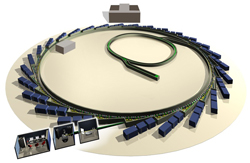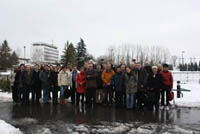 |
 |
|||||||||||||
|
|||||||||||||
|
|||||||||||||
|
Not all people who have the same goals use the same means to achieve them — just think of the two proposed electron-positron colliders ILC and CLIC. And not all people who use the same means also pursue the same goals. A workshop held in January at CERN in Geneva brought the two linear colliders and many of the world's light sources and B-factories together to discuss one common problem: how to make your beam as small and intense as possible to either produce more particle collisions or produce more brilliant light for your light source users, or in short: how to design or operate low-emittance rings.
Organised by the ILC/CLIC working group on damping rings, it was the first meeting that brought light source, B-factory, test facility and damping ring experts together to discuss common issues like machine design, different technologies and beam dynamics challenges. What came out in the end was more than just interesting discussions — participants took home solutions to problems they didn't know they were going to face or designs for parts they didn't know existed already. “There is such an enormous potential in this collaboration to exploit all the similar work efforts,” says local organiser and CLIC damping ring expert Yannis Papaphilippou. “It was good to see the community uniting under the common goal of creating low-emittance beams. We are looking forward to the results of ten new task groups.” Because particles within a beam repel each other, and because no magnet arrangement is perfect, particle beams have the annoying tendency to spread out in all directions. Damping rings are there to 'cool' the beams — to force them to give off energy and thus bring them onto the same level both in terms of energy and in terms of size. Depending on the different design parameters of different machines, the spread of the beam, its emittance, has to be low to extremely low (0.8 picometres in the vertical plane for CLIC) — the record emittance at the workshop was shared by the UK light source Diamond and the Swiss light source at PSI with close to 2-3 picometres each, whereas the accelerator physicists of the Australian Light Source think they have already gone lower than that. A common means of achieving low emittance is to put so-called wigglers in the paths of the beams: their array of short magnets with changing polarity forces charged particles on a wiggly course, which in turn forces them to give off energy in the form of photons. Light sources use these photons to create very intense, or very brilliant, beams of light to direct onto samples and experiments. Damping rings hand the wiggled and thus cooled beam over to the main linear accelerator where they get accelerated and directed onto their counterparts. The wigglers can be tricky things because some have to be superconducting to produce the right light wavelength, or desired dampening effect. A superconducting wiggler produced by the Russian Budker institute that has proved itself in the UK light source Diamond is a potential technology for linear collider damping rings. Novel technologies using different types of superconducting wires are presently being tested at CERN. And in Cornell's CESR-TA, superferric wigglers are used for damping the beam to a very low horizontal emittance: “we found out a lot of the technical challenges of these wigglers and this experience will surely be used in the future,” says Papaphilippou. Another example of fruitful cross and re-fertilisation of the two fields photon science and particle physics (via accelerator physics) is the lattice, or magnet design and arrangement, of the planned ILC damping rings. The ILC damping ring lattice faces a drastic potential change if its circumference is reduced from 6.4 to 3.2 kilometres, as proposed in the SB2009 document. As the community is quick to adapt, they came up with a variant of lattice which was originally designed for the SuperB rings at INFN, Frascati. CLIC scientists are also considering the new set-up for their damping ring. And light source experts are warned about an effect called intra-beam scattering that hasn't been a problem so far, but may become one in the future — now due to the damping rings effort for simulating the effect, there is much more knowledge of how to deal with it. There will be a follow-up workshop next year on the different task groups. In the meantime the organising committee welcomes input from all participants (and those who could not make it) on common design issues and challenges. Send an email to yannis@cern.ch -- Barbara Warmbein |
|||||||||||||
| © International Linear Collider |

